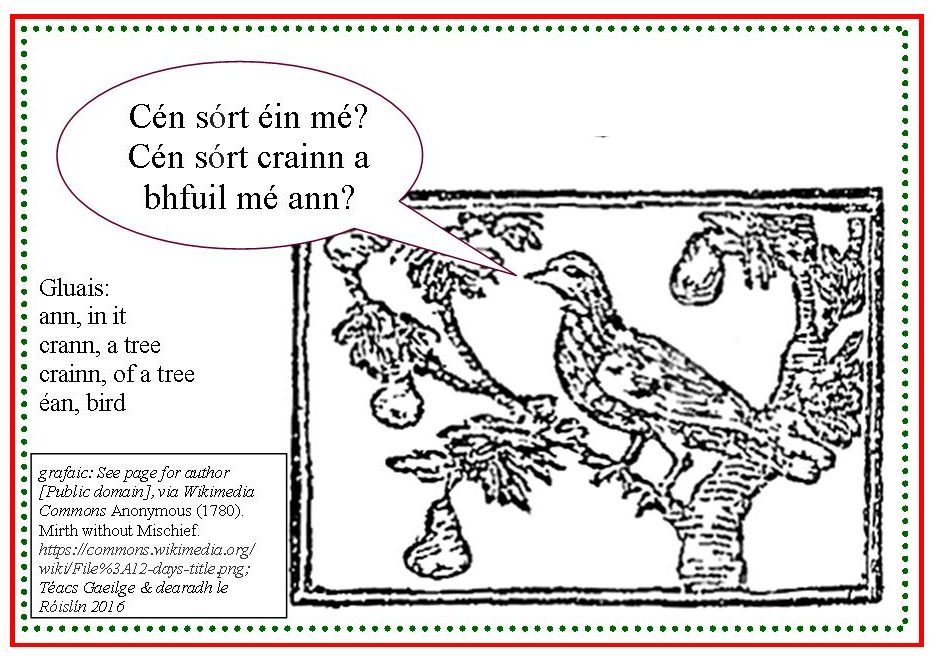Cén sórt éin? Cén sórt crainn? — Learning Irish from the Christmas Carol ‘Dhá Lá Dhéag na Nollag’ (12 Days of Christmas) Posted by róislín on Dec 20, 2016 in Irish Language

grafaic: See page for author [Public domain], via Wikimedia Commons Anonymous (1780). Mirth without Mischief.
https://commons.wikimedia.org/wiki/File%3A12-days-title.png; Téacs Gaeilge & dearadh le Róislín 2016
Cén sórt éin mé? Cén sórt crainn a bhfuil mé ann? Yes, you’ve probably guessed the answers, given the season that’s in it. The bird is a partridge and the tree is the pear tree from the Christmas carol, “The Twelve Days of Christmas.”
In a whole slew of previous blogposts, we’ve looked at various ways to use the Irish version of this song for language learning practice, especially for counting and for expanding vocabulary, particularly regarding birds and (admittedly non-typical) occupations (like being a milkmaid). A webliography of the iarbhlagmhíreanna for the song “Dhá Lá Dhéag na Nollag” appears below.
But who would have thought that a “carúl Nollag” could lend itself so readily to a nice little lesson regarding “an tuiseal ginideach,” aka the oft-dreaded genitive case. It’s not so bad, really — you just have to learn five basic sets of endings (like -áin for “cupán” if you want to say, for example, the color of the cup: dath an chupáin, or “-eora” for “múinteoir” if you want to say “the name of the teacher”: ainm an mhúinteora.”).
And we could go on go héigríoch agus thairsti, with additional details on this topic: variations for broad and slender word endings (like using “-óra” instead of “-eora,” as, for example, in “ainm an stiúrthóra,” the name of the director), variations even within one word (like “talaimh” and “talún” for “talamh“), the motley assortment which is the fifth declension (including both “beoir / beorach” and “athair /athar“), and the complete grab-bag which is labeled “irregular,” like “bean / mná” and “lá / lae.”
But for today, we’ll just like at two types of genitive case use, one for “éan” and “crann,” and one for “An Nollaig.”
So if “éan” means “bird,” how do we say, “of a bird,” for a question like “What sort of (a) bird am I?” as we see in the graphic above. The word “éan” changes to “éin” and the question is: Cén sórt éin mé?
Agus an freagra, “Is patraisc mé.” (I’m a partridge).
Similarly, if we want to say “of a tree,” we change “crann” (tree) to “crainn” (of a tree, and note the pronunciation change — like “krin,” with a short “i,” as opposed to “crann,” which is usually more like “krahn” or “kraun.”
So, an Q & A beag: Cén sórt crainn a bhfuil mé ann? (What kind of a tree am I in? Freagra an-simplí (gan abairt iomlán): crann piorraí (a pear tree, lit. a tree of pears).
A little more complex would be a full sentence: Tá mé i gcrann piorraí.
And then there’s always: Is crann piorraí é
Or: Crann piorraí is ea é.
We’ll wrap up today’s blogpost with a quick look at how “An Nollaig” (Christmas) changes to say “of Christmas” or to use “Christmas” as an adjective (as in “Christmas carol). “Nollaig” belongs to the fifth declension, that is the “grab-bag” category, so it’s not part of any widespread pattern. We remove the “i” for the genitive case, as in “Mí na Nollag” (December, lit. the month of Christmas), carúl Nollag (a Christmas carol), and Dhá Lá Dhéag na Nollag (The 12 Days of Christmas).
So, that’s it for today, patraiscí, piorraí, agus roinnt patrún don tuiseal ginideach. Guess what’s coming up for the next few blogposts as well? Well, we’ve got a delightful 11 more verses to go, but don’t worry, we’ll consolidate a few of them together into fewer blogposts so we won’t be doing an tuiseal ginideach non-stop until mí na Feabhra! SGF — Róislín
Blaganna Eile faoin Amhrán Seo:
2010: https://blogs.transparent.com/irish/dha-la-dheag-na-nollag-the-twelve-days-of-christmas/ Dhá Lá Dhéag na Nollag (The Twelve Days of Christmas), Posted on 25. Dec, 2010
2010: https://blogs.transparent.com/irish/cearca-francacha-agus-lonta-dubha-cuid-a-do-don-tsraith-dha-la-dheag-na-nollag/ Cearca Francacha agus Lonta Dubha (Cuid a Dó don tSraith: Dhá Lá Dhéag na Nollag) Posted on 29. Dec, 2010
2010: https://blogs.transparent.com/irish/%E2%80%9Cor%E2%80%9D-%E2%80%9Coir%E2%80%9D-or-%E2%80%9Corga%E2%80%9D-%E2%80%9Cfainne%E2%80%9D-or-%E2%80%9Cean%E2%80%9D-ean-cuid-a-tri-dha-la-dheag-na-nollag/ “Ór,” “Óir” or “Órga”? “Fáinne” or “Éan”? Éan?! (Cuid a Trí: Dhá Lá Dhéag na Nollag) Posted on 31. Dec, 2010
2011: https://blogs.transparent.com/irish/geanna-agus-ealai-cuid-a-ceathair-dha-la-dheag-na-nollag/ Géanna agus Ealaí (Cuid a Ceathair: Dhá Lá Dhéag na Nollag) Posted on 04. Jan, 2011
2011: https://blogs.transparent.com/irish/na-huimhreacha-pearsanta-i-ngaeilge/ Na hUimhreacha Pearsanta i nGaeilge (Irish Personal Numbers and Cuid a Cúig or the Last Installment of Dhá Lá Dhéag na Nollag) Posted on 06. Jan, 2011
2012: https://blogs.transparent.com/irish/bunuimhreacha-orduimhreacha-is-maoluimhreacha-a-thiarcais-oh-my/ Bunuimhreacha, Orduimhreacha is Maoluimhreacha — A Thiarcais! (Oh my!) Posted on 25. Dec, 2012
2013: https://blogs.transparent.com/irish/speaking-of-pigeons-coluir/ Speaking of Pigeons (Colúir)Posted by róislín on Dec 14, 2013 in Irish Language
2013: https://blogs.transparent.com/irish/ce-mhead-patraisc-ce-mhead-drumadoir-or-12-la-na-nollag-redux-and-an-irish-counting-lesson-to-boot/ (Cé Mhéad Patraisc? Cé Mhéad Drumadóir? (or ’12 Lá na Nollag’ Redux and an Irish Counting Lesson to boot) Posted on 18. Dec, 2013 by róislín in Irish Language
2015: https://blogs.transparent.com/257 woirish/the-irish-twelve-days-of-christmas-redux-redux-with-a-blogliography-of-other-blogs-on-the-song/ The Irish Twelve Days of Christmas Redux Redux with a Blogliography of Other Blogs on the Song Posted by róislín on Dec 25, 2015 in Irish Language

Build vocabulary, practice pronunciation, and more with Transparent Language Online. Available anytime, anywhere, on any device.




Leave a comment: